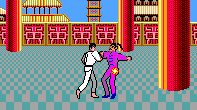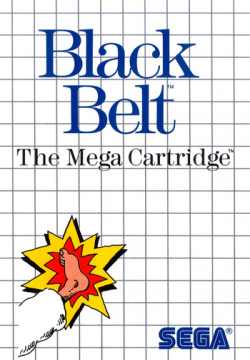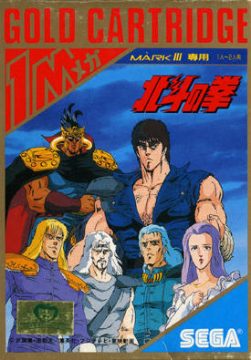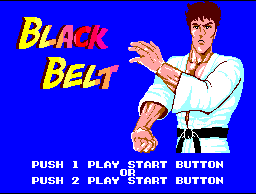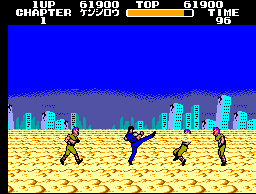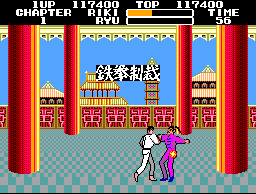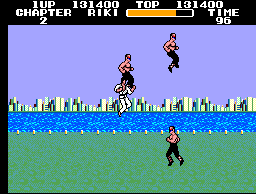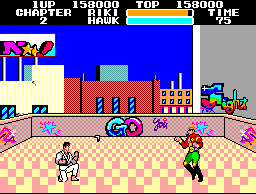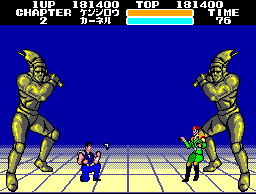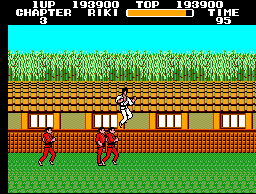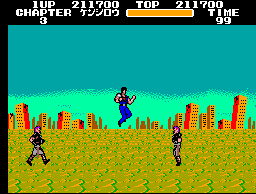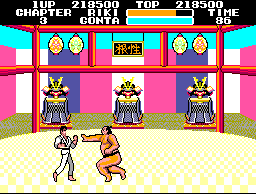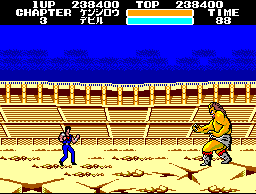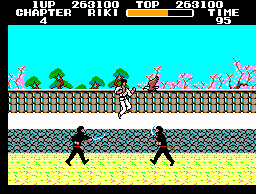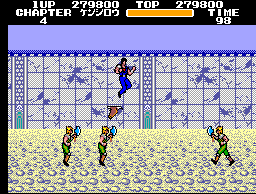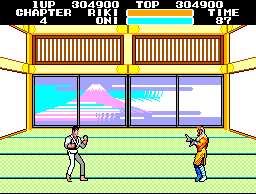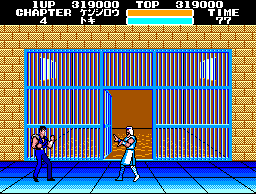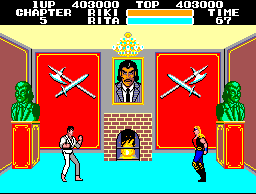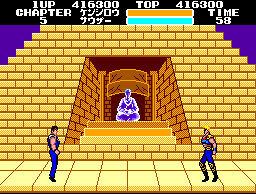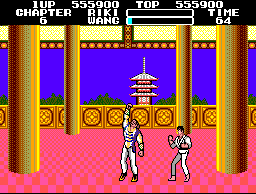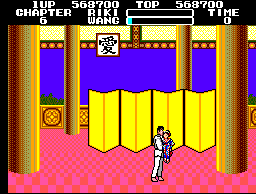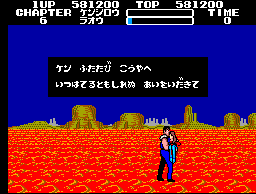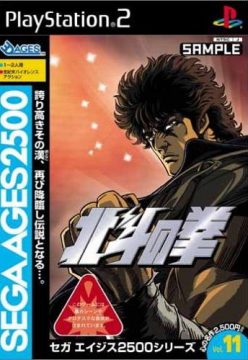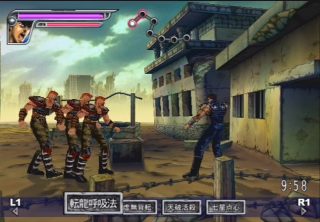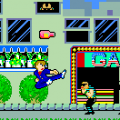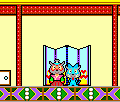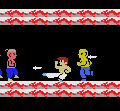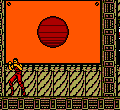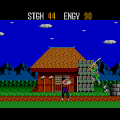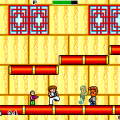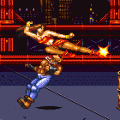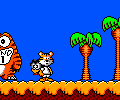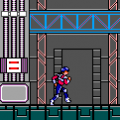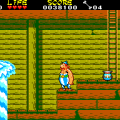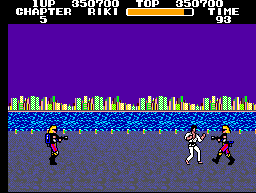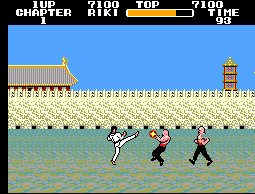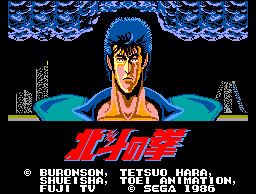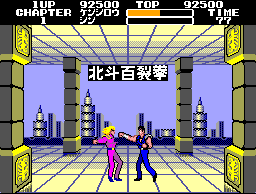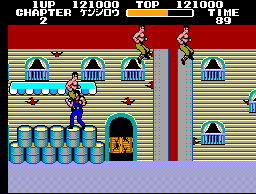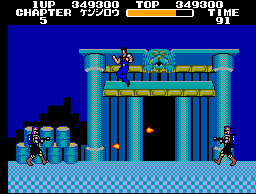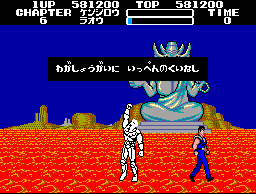Fist of the North Star (Hokuto no Ken) is a manga (and anime) features the manliest man in existence, a dude named Kenshiro who can use his martial arts to make practically anyone more or less explode. There are muscles and dudes screaming at each other and tons of blood Every page oozes massive amounts of testosterone
Fist of the North Star should have made for some awesome video games, but like most licensed properties, it didn’t. There was an early PC text adventure that was pretty decent, an okay 3D beat-em-up for the PlayStation, and a 2D fighting game by Arc System Works, similar to their Guilty Gear games. But most the the earlier Nintendo games for the Famicom and Super Famicom are nothing but tragedy after tragedy. In the early days, at least in the console space, the only decent game was Sega’s own Hokuto no Ken game. It was one of the first games that involved programmer Yuji Naka, one of the core members of Sonic Team, and
Functionally, it’s little more than a rip-off of Irem’s Kung Fu Master (AKA Spartan X), it controls much better. You walk from left to right, punching, kicking, and jump kicking bad guys. Every once in awhile, the screen will stop scrolling for you to pummel a mini-boss, before allowing to proceed. The levels are much more varied than the repetitive palace of Kung Fu Master. In fact, it has some really fantastic visuals, with some extremely impressive parallax scrolling backgrounds. Plus, whenever Kenshiro hits an enemy, they shatter across the screen. Not exactly the blood and gore of the manga, but close enough.
But one of the biggest draws is the one-on-one boss battles, which feature huge character sprites that look totally amazing for an 8-bit game, and predate most other 2D fighters, including Capcom’s Street Fighter. The controls aren’t much different than the main levels (though since you always face your opponent, you can’t turn around, you just walk backgrounds), but these battles are more like a puzzle, trying to find your opponent’s vulnerabilities and then exploiting them. If you don’t, then your attacks are basically useless.
The manga was unheard of in the States during the mid-80s, so Sega decided to change around all of the graphics, and rename it Black Belt. In this version, the player controls a karate master wearing a gi, fighting in modern-day Asian landscapes to fight evil and rescue your girl. In Hokuto no Ken, the player controls Kenshiro, fighting through post apocalyptic wastelands and beating up characters from the manga. Some (but not all) of the music is different. The only major change is that Black Belt gives you health restoration power-ups (usually in the form of sushi flying through the air) while Hokuto no Ken gives you almost none. Strangely, the invincibility power-up in Hokuto no Ken is a letter “P”, while it’s the Japanese symbol for “strength” in Black Belt. Here’s a level-by-level gallery detailing the changes. It’s especially to cool to see how they changed the iconic Fist of the North Star characters into regular schmucks.
The first level is Southern Cross Town in Hokuto no Ken, but appears to be some kind of stadium in Black Belt. Note that many of the midbosses are the same in both versions. The final one before you proceed to the boss is the infamously obese Mr. Heart.
Whenever the player kills a boss, there’s a cinema of the hero pummelling the enemy into submission. These are generally awesome. Hokuto no Ken features the name of the attack during these scenes, while Black Belt keeps them but alters them to use different symbols. The first battle in Hokuto no Ken is against Shin. After the battle, Kenshiro discovers the fake Yuria and heads to the next stage. This is absent in Black Belt.
This level, God Land, is the only one that’s really different in Hokuto no Ken. Both the player and enemies can jump on barrels and ledges, making this the only area that has platforms and isn’t just a straight line. There’s none of this in Black Belt, where the stage is just an open field against the background of a waterfront.The Colonel is a master of boomerangs. In Black Belt, he was changed into some dude named Hawk.
The third stage is kinda cool – in Hokuto no Ken it’s just a palette swap of the first stage (it’s called Devil Rebirth), but it has whole new graphics in Black Belt, and takes place in on a Japanese farm. The tiny little guys in the red outfits have sorta funny looking heads.
This is the only boss that’s different. In Hokuto no Ken, Kenshiro faces off against a fire breathing monstrosity named Devil. This wouldn’t fly given Black Belt‘s modern day setting, so Sega turned him into a sumo wrestler, removed the fire attack, and slightly changed his attack pattern. Also notice how Hokuto no Ken uses the small Kenshiro sprite for this battle instead of the large one normally used for boss battles.
The fourth stage in Hokuto no Ken is the Legend of Cassandra. The midbosses are the the whip wielding Wiegel and those two turban clad guys with swords. In Black Belt, the level was changed to a Japanese garden, and the axe wielding warriors were changed into ninjas.
This boss is really strange in both versions. The only way to beat him is by exchanging blows until he dies. In Black Belt, he simply disappears into thin air, leaving only his mask on the ground. It’s pretty creepy! In Hokuto no Ken, Kenshiro faces off against Toki after he’s been rescued. After the fight, Toki simply walks away and says something before you continue to the next stage. (This fight doesn’t happen in the manga – it could be surprised that this was a misplaced battle against the fake Toki, but that was before the Cassandra Level chapter.)
This is a palette swapped retread of level 2 in both versions. It’s supposed to the Tombstone of the Holy Emperor in Hokuto no Ken.
Thouther/Souther was changed into a girl named Rita. This character looks pretty mannish, even with the long hair they slapped on her. There’s no explanation as to who the random dude in the portrait is.
There’s no stage in level 6, just a boss battle. When Riki defeats Wang, he stumbles into the middle of the screen and then… stretches? The score is then totalled, which apparently means you beat the game. This makes a LOT more sense in Hokuto no Ken, where, after Kenshiro defeats Raou, he points towards the heavens, proclaims that “I have no regrets!” and kills himself by turning into stone – this is one of the most iconic moments in manga history. It’s weird that they’d change the event programming for Oni/Toki back in the fourth stage, but not for Wang/Raou here.
The hero gets the girl. Black Belt has an extra screen of text congratulating the player before it shows the “end” screen. The symbol near the top of the screen means “love”.
Black Belt / Hokuto no Ken is one of the best titles in the Master System’s early line-up – simple, but clever, and a real showcase for the system’s capabilities versus the Famicom. It was well regarded enough in Japan to receive a remake for the PlayStation 2 as part of the Sega Ages 2500 label. Unfortunately, like most of the other Hokuto no Ken games, it’s really, really bad.
Indeed, the PS2 version is more of a reimagining of the original version rather than a remake. It barely even follows the levels or the fights. The original Mark III version was shallow, but still a bit fun – this one is sluggish and boring. Like that game, it’s still a single plane 2D brawler, in that you can only walk left and right, and not up and down like Double Dragon and other beat-em-ups. There are still two primary attack buttons, although they’re just “light” and “heavy” as opposed to “punch” and “kick” of the original version. As you destroy enemies, you build your power gauge. By selecting one of four attacks with the shoulder button, you can execute a variety of special maneuvers.
Despite the extra moves, the controls themselves are much slower than the original version. The stages are rarely more than a few screens long, and you simply walk back and forth killing bad guys until the game is sick of throwing them at you. There are one-on-one boss duels, but while the original version required some interesting tricks to beat your foes, these are fair sloppier. Later in the game, you get to play as Rei and Toki, but they control mostly the same, just with less special moves. The graphics are surprisingly decent considering the quality of other early Sega Ages titles, as they utilize a cel shading technique that makes it look similar to the manga, but you literally fight variations of the same enemy over and over. Unfortunately, there’s also a surprisingly lack of violence. Hokuto no Ken is known for exploding heads and bursting intestines, but other than some small blood splatters, there are very few cool death animations. So really, the only good thing about this package is that it includes an emulated version of the original Mark III release.
Screenshot Comparisons
